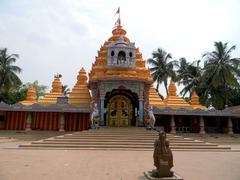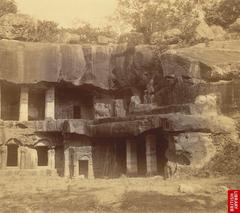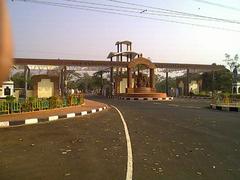Byamokesvara Temple Bhubaneswar: Visiting Hours, Tickets, and Historical Significance
Date: 04/07/2025
Introduction
Located in the vibrant heart of Bhubaneswar—rightfully celebrated as the “Temple City of India”—the Byamokesvara Temple is a remarkable embodiment of Odisha’s spiritual and architectural legacy. Dedicated to Lord Shiva and dating back to the 9th–10th century CE during the Somavamshi dynasty, the temple is a stellar example of the Kalinga style, renowned for its curvilinear spires, ornate carvings, and robust iconography (Orissa Guide; Wikipedia). Situated near the bustling Tala Bazaar and the iconic Lingaraj Temple, it forms a significant part of Bhubaneswar’s sacred landscape and cultural narrative.
This comprehensive guide provides in-depth insights into the temple’s origins, architectural features, religious significance, and practical visitor information, including timings, tickets, accessibility, and travel tips. Whether you are an architecture enthusiast, a spiritual seeker, or a curious traveler, this resource will ensure a meaningful experience at Byamokesvara Temple (TripXL; thefloatingpebbles.com).
Origins and Early History
Byamokesvara Temple, also known as Suresvara Mahadeva Temple, was constructed during the Somavamshi (Keshari) dynasty, a period marked by prolific temple building and the zenith of Kalinga architecture (Orissa Guide). Its strategic location in Tala Bazaar, opposite the eastern gateway of the Lingaraj Temple, cements its place in Bhubaneswar’s spiritual geography—a city that has been a center for Shaivism and architectural innovation since the early medieval era (Travelsnwrite).
The sanctum enshrines a Shiva lingam set within a yonipitha, emphasizing the temple’s deep-rooted Shaivite traditions.
Architectural Features
Kalinga Style and Layout
Byamokesvara Temple exemplifies the Kalinga school of architecture, featuring the classic Rekha Deul (curvilinear sanctum tower) and Jagamohana (assembly hall). The Rekha Deul’s towering spire is adorned with an amalaka (ribbed stone disc), symbolizing the celestial sphere, and intricate carvings that narrate episodes from Hindu mythology (Eklavya Study Point).
The Jagamohana’s pyramidal roof (Pidha Deul) is supported by robust pillars, providing space for congregational worship. The temple sits within a square plan, enclosed by a boundary wall that creates a sacred precinct (Eklavya Study Point).
Material and Construction
The temple is constructed from locally sourced sandstone, assembled with precise joinery and, in places, reinforced with iron clamps and beams—a testament to the engineering skills of its builders (Tourism Orissa; TripXL). The sanctum now lies about 1.5 meters below present road level, a result of centuries of urban development (Wikipedia).
Artistic Detailing
- Exterior Carvings: The walls are richly adorned with depictions of deities, mythological stories, apsaras, and geometric motifs.
- Doorways and Toranas: Elaborate toranas (arched gateways) feature makara (mythical sea creatures), guardian dwarapalas, and narrative friezes (Tourism Orissa).
- Sculptural Iconography: The sanctum houses a Shiva lingam and is guarded by the statue of Nandi the bull. The eight directional guardians (ashta-dikpalas) are represented on the walls.
- Roof and Superstructure: The shikhara is crowned by an amalaka and kalasha, symbolizing cosmic unity and spiritual fulfillment (Eklavya Study Point).
The interior remains austere, focusing attention on the sanctum and deity, while select pillars display lotus motifs and symbolic designs.
Religious and Cultural Significance
Byamokesvara Temple has been a focal point for Shaivite worship and cultural festivities for over a millennium (Orissa Guide). Major festivals such as Maha Shivaratri and Sankranti draw large gatherings and are marked by elaborate rituals and vibrant celebrations (Wikipedia). Local legends tell of Lord Shiva’s protection over the temple during times of invasion, enhancing its aura of sanctity (Hindu Mythology Worldwide).
The temple is actively maintained by local shopkeepers and devotees, reflecting its enduring significance as a living place of worship.
Visiting Hours, Tickets, and Accessibility
- Hours: Open daily from 6:00 AM to 8:00 PM.
- Entry: Free for all, with donations encouraged for maintenance.
- Location: Tala Bazaar, Old Town, Bhubaneswar—easily accessible by auto-rickshaw, taxi, or public transport. The Master Canteen bus stop is a common access point (ebhubaneswar.com).
- Accessibility: While the approach includes some steps and uneven pathways, assistance is available for those with mobility challenges. Ramps are present near the entrance, but full accessibility may be limited.
Travel Tips and Dress Code
- Best Time to Visit: October–March, when weather is pleasant and festivals abound (makemytrip.com).
- Dress Code: Modest attire is required—shoulders, arms, and legs covered for both genders. Remove footwear before entering the temple.
- Photography: Allowed in outer precincts; restricted within the sanctum. Always check signage or ask staff (thefloatingpebbles.com).
- Etiquette: Maintain silence, keep mobile phones on silent, and avoid disruptive behavior. Offerings like flowers and incense can be purchased from nearby vendors.
Facilities and Amenities
- Drinking Water: Available near the entrance.
- Restrooms: Basic facilities nearby.
- Parking: Limited; public transport or auto-rickshaws are recommended during busy hours.
Guided Tours and Interpretation
Local guides are available for hire at the temple or through city tour operators, usually charging INR 200–500 per tour (easeindiatrip.com). Guides enhance the visit with stories, history, and explanations of architectural features.
Accessibility for Differently-Abled Visitors
Due to its ancient construction, full accessibility is limited. The temple approach includes uneven stone steps and narrow pathways. Visitors requiring assistance should plan ahead.
Safety and Security
Bhubaneswar is generally safe for tourists. Remain vigilant, especially during crowded festivals. Secure valuables and use authorized transport. For emergencies, dial 100 (police) or 108 (ambulance).
Nearby Attractions and Suggested Itinerary
- Lingaraj Temple: The largest and most revered temple in Bhubaneswar (ebhubaneswar.com).
- Mukteswara Temple: Known for its ornate torana and carvings.
- Rajarani Temple: Famous for its distinctive architecture.
- Udayagiri & Khandagiri Caves: Ancient Jain rock-cut caves (thefloatingpebbles.com).
- Odisha State Museum: Showcases regional art and history.
A half-day itinerary could cover Byamokesvara, Lingaraj, and Mukteswara temples, followed by a visit to the caves or museum.
Food and Refreshments
Options nearby include traditional Odia cuisine, vegetarian restaurants, and popular snacks such as dahi bara aloo dum and chhena poda (makemytrip.com). Carry bottled water and choose hygienic food stalls.
Cultural Sensitivity and Responsible Tourism
Respect the sanctity of the temple and local customs. Do not touch idols or enter restricted areas. Always seek permission before photographing people or rituals. Support local artisans by purchasing from authorized shops.
Language and Communication
Odia is the primary language, but Hindi and English are widely understood. Tourist signage is typically bilingual, and communication for directions or services is straightforward.
Frequently Asked Questions (FAQ)
Q: What are the temple’s visiting hours?
A: 6:00 AM to 8:00 PM daily.
Q: Is there an entry fee?
A: No; donations are welcome.
Q: Can non-Hindus enter the sanctum?
A: Generally not permitted.
Q: Are guided tours available?
A: Yes, with local guides for hire.
Q: Is the temple accessible for differently-abled visitors?
A: Limited; assistance is recommended.
Q: Is photography allowed?
A: Yes, in outer areas; restricted in the sanctum.
Visuals and Media
- [Insert images of Byamokesvara Temple with alt tags such as “Byamokesvara Temple exterior,” “Intricate carvings at Byamokesvara Temple,” and “Temple entrance in Bhubaneswar.“]
- [Embed map showing Byamokesvara Temple’s location within Bhubaneswar.]
- [Link to virtual tours or video walkthroughs if available.]
Emergency Contacts and Useful Information
- Police: 100
- Ambulance: 108
- Tourist Helpline: 1363 (India-wide)
- Biju Patnaik International Airport: +91-674-2596300
For current timings and updates, refer to the Odisha Tourism website or your hotel’s front desk.
Conclusion and Recommendations
Byamokesvara Temple stands as a harmonious blend of spiritual devotion, historical depth, and artistic brilliance—a living monument that continues to inspire devotees and travelers alike. Its location amidst Bhubaneswar’s constellation of historic shrines makes it a must-visit on any temple circuit (Orissa Guide; Wikipedia). Respect local customs, dress modestly, and consider supporting the temple’s preservation through donations and responsible tourism.
For a seamless experience, use resources like the Audiala app for detailed guides, real-time updates, and curated itineraries. Stay connected with Odisha’s vibrant culture through official tourism platforms and social media.
References and Further Reading
- Byamokesvara Temple Bhubaneswar: History, Visiting Hours, Tickets & Travel Guide, Orissa Guide
- Byamokesvara Temple, Wikipedia
- 10 Must See Temples of Bhubaneswar, Travelsnwrite
- The Temples of Odisha: A Spiritual Odyssey, Hindu Mythology Worldwide
- Byamokesvara Temple Bhubaneswar: Architectural Features, Visiting Hours, and Visitor Guide, Eklavya Study Point
- Bhubaneswar Temples, TripXL
- 7 Must Visit Temples in Bhubaneswar, Tourism Orissa
- Bhubaneswar Top 8 Temples to Visit, The Floating Pebbles
- Explore City: Top 5 Famous Temples to Visit in Bhubaneswar, ebhubaneswar.com
- Top Things to Do in Bhubaneswar, Ease India Trip
- Bhubaneswar Tourism: History, Travel Guide, TravelSetu
- MakeMyTrip: Bhubaneswar Trip Ideas
- Official Odisha Tourism Website








